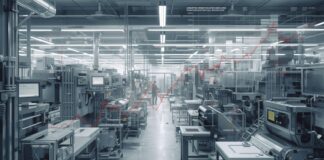
By Mark Hungerford, SVP of Manufacturing Solutions at L2L
Key Takeaways:
- Food manufacturers face significant challenges with maintenance and downtime, costing the industry billions annually.
- Utilizing real-time data through connected workforce platforms, fostering a collaborative approach to maintenance, and adopting proactive maintenance strategies (both predictive and preventive) can help manufacturers overcome these obstacles.
- Implementing these strategies can lead to reduced downtime, improved operational efficiency, extended equipment lifespan, better communication, and increased employee satisfaction, ultimately driving long-term success in food manufacturing.
Unplanned downtime is estimated to cost the industrial manufacturing industry $50 billion each year as a whole. Food manufacturers are no exception. Common roadblocks such as a failure to leverage real-time data, poor internal communications, and outdated processes hold manufacturers back from utilizing all resources and maximizing factory uptime, ultimately costing them millions on maintenance.
If businesses intend to stay competitive in today’s increasingly technology-driven world, it’s critical for them to overcome these maintenance challenges. Failing to do so will lead to lost revenue and capacity, missed customer deliveries, damaged customer relationships, and falling behind competitors. To best overcome these obstacles, let’s look at three ways food manufacturers can take action right now.
1. Utilize real-time data for the best maintenance operation results
Traditionally, plants relied on their workers and maintenance technicians to take diligent notes, keep track of paperwork, and manually input data into their operating systems. The technicians who followed this model (or are still following it) often struggled to find and analyze machine data for optimal reliability, business decisions, or knowledge was lost altogether when more tenured technicians left the workplace. In addition, accessing maintenance reports and machine histories likely required a request to the factory’s IT department — creating such a cumbersome process that many simply ended up not pursuing it.
For one food company, the process of manually recording information and requesting reports needed to pinpoint maintenance issues took an average of three to four days. Since manual data entry is prone to human error, crucial information might not be recorded at all, leading to lost data. Such outdated processes prevent teams from having a complete view of plant operations, as they lack the ability to surface data in real time to address problems immediately.
For food manufacturing plants to become smarter and more efficient, it’s essential to arm frontline workers with the highest quality data across the whole factory while production is in process, not after the fact. Investing in solutions like a connected workforce platform can provide a team with the details of what’s currently happening on the shop floor across any manufacturing dimension: people, process, material, or machine. This data is generated by, consumed by, and turned into action by AI for use by frontline workers. The purpose of a connected workforce platform is to provide everyone across the organization with clarity of what’s happening on the plant floor and enable teams to proactively respond to equipment failures. Digitizing these insights into one platform also provides the full picture of how to effectively increase operational availability and manage plant assets.
2. Foster a collaborative approach to maintenance
To enhance machine and plant productivity, a people-first approach is essential. Focusing on employees sets the foundation for success. Providing workers with standard work guidance and the necessary connectivity empowers them to do their best work together.
One way connected workforce platforms provide immense value to manufacturing plants is by fostering a sense of collaboration that keeps the entire organization on the same page. Additional benefits of these platforms include:
- Goal alignment: provides one central place that clearly outlines company-wide expectations.
- Internal communication: gives organizations the necessary tools to streamline communication and share information and resources immediately.
- Proactive problem-solving: presents technicians and workers with access to the history of the machinery and sends alerts in real-time when something might be wrong or is due for a check-in.
- Automation: allows organizations to automate and standardize work processes to maximize productivity and improve outcomes.
- Employee retention: creates a manufacturing plant that runs smoothly and addresses problems quickly and proactively, also leading to higher employee satisfaction and retention.
A collaborative approach ultimately leads to higher success. It encourages teams to perform their best, maximizes everyone’s contributions, and helps organizations align and achieve production and quality goals.
3. Adopt proactive maintenance strategies
Ensuring that equipment runs safely and efficiently is crucial, especially considering the high costs associated with maintenance and unexpected downtime. Relying on reactive maintenance is not sustainable, as it can lead to missed production quotas, reduced equipment lifespan, and overburdened maintenance technicians.
The best approach for manufacturers is to adopt proactive maintenance strategies — both predictive and preventive. This is where connected workforce platforms truly shine.
Predictive maintenance leverages AI-powered technology to monitor equipment in real time, providing early warnings of potential failures and allowing maintenance teams to address issues before they cause significant disruptions. Connected workforce solutions facilitate this by integrating data from various sources, enabling seamless communication and coordination among team members, which enhances real-time data analysis and proactive corrective actions based on insights gained. This helps reduce costs, extend the life of assets, and minimize the need for extensive spare parts inventory.
In contrast, preventive maintenance focuses on scheduled maintenance activities to prevent unexpected breakdowns. It is based on cycles or fixed intervals and includes tasks such as lubrication, cleaning, inspection, and part replacements. Connected workforce platforms support preventive maintenance by maintaining digital records, scheduling tasks, and ensuring that all maintenance activities are tracked and executed efficiently.
Additionally, connected workforce software can reveal where ongoing machine abnormalities are occurring so that maintenance technicians stop reacting to issues and instead begin engaging in proactive maintenance. By maintaining digital records of abnormality trends and resolutions, technicians have easy access to machine history, an important benefit in their highly regulated manufacturing environment.
By combining proactive maintenance strategies alongside connected workforce platforms, manufacturers can improve operational efficiency, extend equipment lifespan, and reduce downtime, ultimately achieving greater business success.
Conclusion
Adopting a connected workforce platform can be a transformative solution for food manufacturers grappling with maintenance challenges and operational inefficiencies. By leveraging real-time data, fostering collaboration, and adopting proactive maintenance strategies, companies can significantly reduce downtime and maintenance costs.
Embracing these advancements is not only about staying competitive; it’s about paving the way for a smarter, more efficient future in food manufacturing. If plants want to reach their full potential, focusing on digitization and the adoption of connected workforce platforms will be mission-critical for maintaining high productivity and achieving long-term success.
 Mark Hungerford is the Senior Vice President of Manufacturing Solutions at L2L. With over two decades of experience in the manufacturing sector, Mark is committed to leveraging technology to optimize manufacturing processes and improve efficiency.
Mark Hungerford is the Senior Vice President of Manufacturing Solutions at L2L. With over two decades of experience in the manufacturing sector, Mark is committed to leveraging technology to optimize manufacturing processes and improve efficiency.







